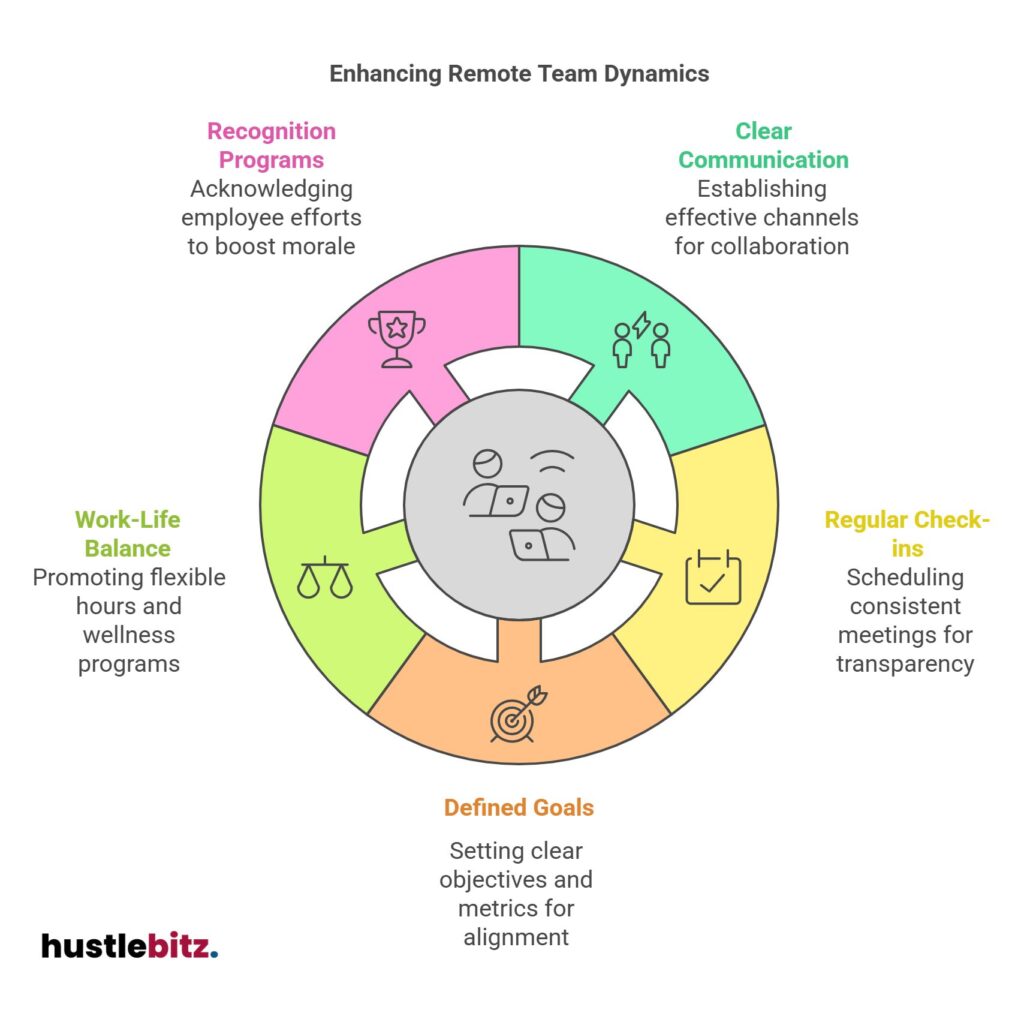To effectively manage a remote team and boost productivity, establish clear communication channels using video conferencing and messaging tools. Schedule regular check-ins to maintain transparency and foster engagement across time zones. Set defined goals and performance metrics to align team efforts and monitor progress. Encourage a healthy work-life balance through flexible hours and wellness initiatives. Provide continuous feedback to support employee development and implement recognition programs to motivate your team. Investing in team-building activities can enhance collaboration and camaraderie. These strategies can significantly improve team dynamics; further insights can enhance your management approach even more.
Key Takeaways
- Establish clear communication channels using video conferencing and project management tools to enhance collaboration among remote team members.
- Schedule regular check-ins with clear agendas to foster transparency and accountability across different time zones.
- Set defined goals and performance metrics to ensure alignment and clarity on individual responsibilities within the team.
- Promote work-life balance by encouraging flexible hours and wellness programs to reduce stress and enhance productivity.
- Implement recognition programs to acknowledge employee efforts, boosting morale and motivation within the remote team.

Establish Clear Communication Channels

To ensure effective collaboration within a remote team, it is essential to establish clear communication channels that facilitate timely and transparent exchanges of information. Utilizing a combination of video conferencing tools and instant messaging apps can significantly enhance real-time communication, allowing team members to connect seamlessly regardless of their physical locations. These platforms enable instant feedback loops, which are vital for maintaining project momentum and addressing concerns promptly.
Moreover, adhering to email etiquette guidelines is crucial in formal communications, ensuring clarity and professionalism. This includes being concise, using appropriate subject lines, and maintaining a respectful tone. It is also important to recognize different communication styles among team members, as this awareness fosters a more inclusive environment.
Incorporating project management software can streamline updates and task assignments, ensuring everyone is aligned on project goals. Furthermore, establishing robust documentation practices allows for effective knowledge sharing, helping team members stay informed and reducing the likelihood of misunderstandings.
Cultural sensitivity training should not be overlooked, as it equips team members with the skills to navigate diverse communication preferences and conflict resolution strategies. This training promotes respect and understanding, which are essential in remote collaboration.
Lastly, utilizing team collaboration platforms can centralize discussions, making it easier to track conversations and decisions. By implementing these strategies, remote teams can create a cohesive communication framework that enhances productivity and fosters a positive working environment.
Set Defined Goals and Expectations
Setting defined goals and expectations is crucial for maintaining focus and accountability within a remote team. Clearly articulated objectives help ensure goal alignment among team members and foster a shared understanding of project timelines. Establishing performance metrics allows for effective task prioritization and aids in milestone tracking, ensuring that progress is measurable and visible.
To achieve outcome clarity, it is essential to define success criteria for each project. This involves creating specific role definitions that clarify individual responsibilities and contributions. By doing so, teams can enhance accountability measures, as each member knows what is expected of them and how their performance will be assessed. Moreover, implementing feedback loops can facilitate ongoing discussions about progress, allowing for adjustments and improvements along the way.
Here’s a table summarizing the key components of setting defined goals and expectations:
| Component | Description | Importance |
| Goal Alignment | Ensures all team members are working towards the same objectives | Promotes unity and direction |
| Performance Metrics | Measures progress against defined standards | Provides a basis for evaluation |
| Accountability Measures | Sets expectations for individual contributions | Enhances responsibility and ownership |
| Milestone Tracking | Monitors progress by tracking significant achievements | Keeps the team on schedule |
| Feedback Loops | Encourages regular input on performance and challenges | Fosters continuous improvement |
Schedule Regular Check-Ins

How frequently should team members engage in regular check-ins to ensure effective communication and alignment in a remote work environment? Establishing a consistent schedule for check-ins is essential, as it fosters transparency and promotes team availability. Depending on the complexity of projects and team dynamics, weekly or bi-weekly meetings can provide a structured opportunity for updates and discussions.
Incorporating various check-in formats—such as one-on-one meetings, team huddles, or asynchronous updates—can enhance engagement and cater to different preferences. Time zone coordination is crucial in scheduling these check-ins, ensuring that all team members can participate without undue inconvenience. Additionally, adhering to virtual meeting etiquette, such as being punctual and prepared, reinforces professionalism and respect among team members.
Effective agenda setting is necessary to maximize the productivity of each check-in. Clearly defined topics should be shared in advance, allowing participants to prepare relevant updates and insights. Moreover, establishing feedback frequency during these sessions promotes continuous improvement and helps monitor performance metrics.
Utilizing remote tools for documentation and follow-ups enhances accountability structures, ensuring that action items are tracked and addressed. This not only strengthens team cohesion but also fosters a culture of accountability and responsibility amongst team members.
Ultimately, regular check-ins are pivotal in maintaining employee engagement, allowing teams to celebrate successes and identify challenges collaboratively. By prioritizing these interactions, remote teams can cultivate a supportive environment that drives productivity and alignment toward shared goals.
Encourage Work-Life Balance
Promoting a healthy work-life balance is essential for enhancing employee well-being and maintaining productivity within remote teams. In a remote work environment, the lines between professional and personal life can often blur, making it crucial for managers to encourage practices that foster a balanced lifestyle. Implementing flexible hours allows team members to tailor their schedules according to personal commitments, ultimately enhancing time management and reducing stress.
To support mental health, organizations should consider offering wellness programs that focus on both physical and emotional well-being. These programs can provide remote resources such as virtual counseling and mindfulness workshops, which contribute to burnout prevention. Furthermore, it is vital to encourage employees to establish personal boundaries, ensuring they disconnect from work after hours to recharge effectively.
Incorporating regular productivity breaks can also help remote workers maintain focus and energy throughout the day. Encouraging team members to take time for self-care or family support can lead to improved morale and job satisfaction. By promoting lifestyle integration, employees can better manage their responsibilities while remaining productive in their roles.
Ultimately, fostering an environment that values work-life balance is not just beneficial for employees; it also enhances overall team performance. By recognizing the importance of well-being and implementing supportive measures, managers can create a thriving remote workforce poised for success.
Provide Continuous Feedback

Providing continuous feedback is essential for fostering growth and engagement within remote teams, enabling employees to understand their performance and align with organizational goals.
Implementing effective feedback loops ensures that team members receive timely insights into their work, promoting a culture of improvement and transparency. Regular remote check-ins can facilitate constructive criticism, allowing managers to address challenges and celebrate successes in real-time.
In addition to one-on-one discussions, incorporating peer evaluations can enhance the feedback culture by allowing team members to share insights and support each other’s skill development.
Establishing recognition programs can further motivate employees, as acknowledgment of their efforts contributes to a positive work environment.
Utilizing performance reviews at regular intervals helps to formalize the feedback process, while anonymous surveys can provide valuable insights into team dynamics and areas for improvement.
These tools empower employees to voice their opinions without fear of repercussion, fostering an atmosphere of open dialogue.
Invest in Team Building Activities

Investing in team building activities is crucial for enhancing collaboration and camaraderie among remote team members, fostering a sense of belonging that can significantly boost overall productivity. In a virtual environment, where face-to-face interactions are limited, engaging in activities designed to strengthen relationships becomes essential.
Virtual team building can take many forms, from icebreaker games that help team members learn about each other to comprehensive online workshops aimed at skill development. These activities not only break the monotony of daily tasks but also create opportunities for individuals to share their unique talents through skill sharing sessions.
For a more immersive experience, consider organizing remote retreats that allow teams to collaborate on projects while enjoying a change of scenery, albeit virtually. Themed events can also add an element of fun, encouraging creativity and participation. Incorporating wellness activities, such as guided meditation or fitness challenges, can further enhance team morale and well-being.
Additionally, trivia nights and fun challenges can foster friendly competition, helping to build stronger bonds among team members. Such activities remind employees that they are part of a larger community, which is vital in a remote setting.
Monitor Performance and Progress

Building strong relationships through team building activities sets the foundation for effective performance management, making it important to monitor progress and productivity within a remote team.
Implementing performance metrics is crucial for ensuring that team members are aligned with organizational goals. These metrics should be clear, measurable, and relevant, facilitating straightforward progress tracking.
To bolster accountability measures, utilize productivity tools that fit the unique remote workflows of your team. These tools enable real-time data analysis, allowing you to assess individual and team performance continuously.
Regular performance reviews should be structured to not only evaluate outcomes but also to foster constructive feedback loops that enhance team dynamics. By engaging in open discussions about performance, team members can feel more connected and motivated.
Incorporating outcome assessments ensures that team members understand their contributions to overall objectives. Regular check-ins can help identify barriers to success and adjust strategies as necessary. This proactive approach to monitoring performance cultivates a culture of accountability and transparency, essential for remote teams.
Ultimately, the key to effective performance management lies in balancing oversight with empowerment. By employing a combination of performance metrics, feedback loops, and productivity tools, leaders can create an environment where remote employees thrive.
This fosters a sense of ownership and encourages continuous improvement, directly impacting the overall productivity of the team.
Final Thoughts
Effectively managing a remote team requires a combination of clear communication, goal setting, regular check-ins, and continuous feedback. By fostering a positive work-life balance and investing in team-building activities, you can enhance collaboration and maintain high levels of productivity. Monitoring performance through established metrics and providing consistent feedback helps keep your team aligned and motivated. As remote work continues to be a significant part of the modern workforce, implementing these strategies will ensure that your team remains productive, engaged, and successful in achieving its goals.




